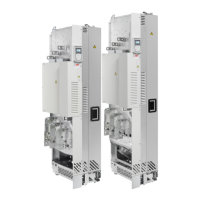56 Guidelines for planning the electrical installation
Note: When continuous metal conduit is employed, shielded cable is not required. The
conduit must have bonding at both ends.
A four-conductor system is allowed for input cabling, but shielded symmetrical cable is
recommended.
Compared to a four-conductor system, the use of symmetrical shielded cable reduces
electromagnetic emission of the whole drive system as well as the stress on motor
insulation, bearing currents and wear.
Sufficient conductivity of the protective conductor
The protective conductor must always have an adequate conductivity.
Unless local wiring regulations state otherwise, the cross-sectional area of the protective
conductor must meet the conditions that require automatic disconnection of the supply
required in 411.3.2. of IEC 60364-4-41:2005 and be capable of withstanding the
prospective fault current during the disconnection time of the protective device.
The cross-sectional area of the protective conductor can either be selected from the table
below or calculated according to 543.1 of IEC 60364-5-54.
This table shows the minimum cross-sectional area related to the phase conductor size
according to IEC 61800-5-1 when the phase conductor and the protective conductor are
made of the same metal. If this is not so, the cross-sectional area of the protective earthing
conductor shall be determined in a manner which produces a conductance equivalent to
that which results from the application of this table.
Cross-sectional area of the phase
conductors
S (mm
2
)
Minimum cross-sectional area of the
corresponding protective conductor
S
p
(mm
2
)
S <
16 S
16 < S <
35 16
35 < S S/2

